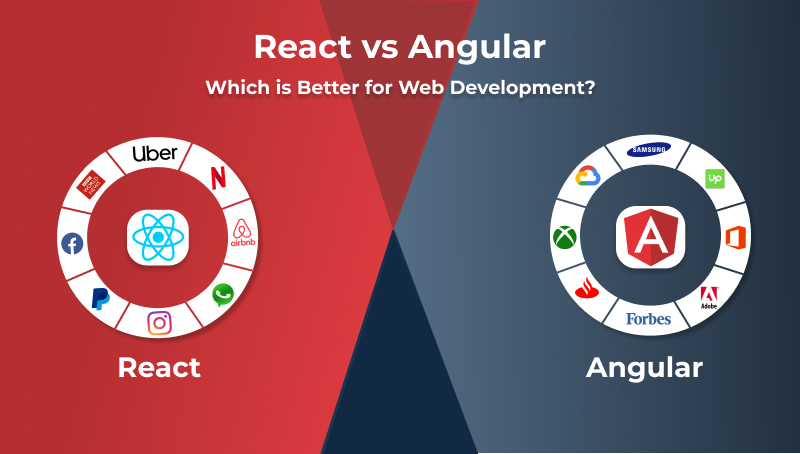This blog presents a comprehensive comparison of Angular vs. React based on various factors, helping you evaluate which one is better suited for your project.
If you own a bakery, which item would you display to entice your customers the most? Would it be a strawberry shortcake or a New York cheesecake? It’s difficult to decide right? Developers often face the same dilemma when deciding to use React vs. Angular for designing their website elements.
When it comes to front-end development, most people turn to either Angular or React to implement their ‘client side’ needs. React and Angular, as JavaScript ecosystems, are responsible for facilitating the implementation of the visual elements that users perceive and engage with on a website. They provide developers with the necessary tools, libraries, and frameworks to build interactive and visually appealing user interfaces.
For some, comparing React and Angular is as absurd as comparing apples to oranges. Angular and React have distinct differences in their underlying technologies. Angular is a TypeScript-based framework, while React is a JavaScript library that uses JSX.
By incorporating additional libraries, React can be transformed into a complete framework. That’s why React is often mentioned together with other JavaScript frameworks like Angular and Vue.js. However, it’s important to note that the workflow and stack of the resulting framework are still significantly different from Angular.
Despite their differences, both React and Angular share a component-based architecture, which means they provide reusable and modular elements to solve similar front-end challenges. As a result, there is an ongoing debate in the development community regarding the merits of Angular vs React.
What is React?
React is a JavaScript library used for creating user interfaces by assembling reusable UI components. It employs server-side rendering, offering flexibility and high performance. React enables developers to build seamless user experiences and complex user interfaces. If you want optimal UI/UX results, you can rely on React front-end development services.
React adheres to the principle of “Learn Once, Write Anywhere,” making it a popular choice among developers for building fast and scalable applications. In addition to JavaScript, React can also be used with JSX. Facebook initially developed React and it is currently maintained by a community of Facebook and individual developers.
Here are some advantages of using React:
- Reusable and predictable code: React allows for the creation of reusable UI components, resulting in more efficient and maintainable code.
- Easier debugging: With React’s declarative views, identifying and fixing issues becomes simpler, leading to smoother debugging processes.
- Faster development: React’s efficient development workflow, component reusability, and availability of various tools and libraries contribute to faster project development.
- Enhanced developer productivity: React’s component-based approach and modular structure enable developers to work more productively, collaborate effectively, and iterate quickly.
- Easy migration between versions: React provides support and tools for easy migration between different versions, making it convenient to adopt newer features and enhancements.
- Mobile app development with React Native: Using React Native, developers can build mobile applications that allow for the creation of cross-platform apps with a single codebase, streamlining the mobile app development process.
- Faster updates: React’s virtual DOM and server-side rendering capabilities enable faster updates and better overall performance, both on the server and client sides.
- Improved load time and performance: React’s efficiently built user interfaces contribute to improved load times and overall performance, enhancing the user experience.
- Integration with third-party libraries: React seamlessly integrates with a wide range of third-party libraries and frameworks, allowing developers to leverage existing tools and resources.
What is Angular?
Angular, developed and maintained by Google’s Angular team, is a widely adopted open-source JavaScript front-end framework. It is the preferred choice for building scalable and high-performance web and mobile applications using HTML, CSS, and TypeScript. The latest version of Angular is Angular 13, which provides robust solutions for enterprise-grade web development and is widely embraced by companies.
Due to its robust features such as two-way data binding, dependency injection, and the backing of a major technology company, Angular rapidly gained popularity and became one of the most widely used web frameworks at the time. It follows the MVC (Model View Controller) architectural pattern, which organizes tasks into logical components and enhances the initial page loading speed.
Here are some advantages of using Angular:
- Strong encapsulation and intuitive application structure: Angular promotes a modular and organized structure, making it easier to manage and scale complex applications.
- Clean code development: Angular encourages writing clean and readable code, improving code maintainability and reducing potential bugs.
- Easy building, maintenance, testing, and updates: Angular provides a streamlined development process, facilitating efficient building, testing, and updating of applications.
- In-built features like RxJS and AngularCLI: Angular comes bundled with powerful features like RxJS for reactive programming and AngularCLI for generating components, services, and other project elements.
- Built-in support for HTTP, AJAX, and Observables: Angular offers built-in support for handling HTTP requests, AJAX calls, and working with Observables, simplifying data fetching and manipulation.
- Rapid server-side rendering: Angular enables quick server-side rendering, enhancing initial page load times and improving overall performance.
- Support for non-browser rendering views: Angular allows for rendering views that are not dependent on browser capabilities, making it suitable for various platforms and environments.
- Reduced code length through parallel component execution: Angular’s ability to execute components in parallel results in fewer lines of code, improving development efficiency.
- Improved developer productivity: Angular’s robust tooling, comprehensive documentation, and extensive community support contribute to enhanced developer productivity.
- Increased application performance: With optimizations and efficient rendering techniques, Angular helps achieve high performance and responsiveness in applications.
A Comprehensive Comparison
| Base for Distinction | React | Angular |
| Developed and Maintained by | Meta & Community | |
| Purpose | Build interactive UI components | Develop dynamic web apps |
| Language | JavaScript (JSX) | TypeScript |
| Data Binding | One-way | Two-way |
| Componentization | Components are achieved by encapsulating all the HTML and JavaScript needed for a UI component in a single JSX file. Supports both class and functional (stateless) components. | Componentization is accomplished by encapsulating the selector, template, style, and other properties that constitute the essential metadata for processing a component. |
| Dependency Management | Supports dependency injection, allowing for separate lifecycles for different stores | Supports dependency injection, allowing for separate lifecycles for different stores |
| Front-end Development Approach | Uses XML-like syntax called JSX, slight preference for server-side rendering | Extends the functionality of HTML, prefers client-side rendering |
| DOM (Document Object Model) | Virtual | Real |
| Performance | Relatively high (since virtual DOM renders updates much faster & ensures fast runtime performance) | High |
| App Structure | Flexible, component-based | Fixed and complex platform, component-based framework |
| Learning Curve | Relatively small | Can be steep for beginners |
| Ideal Use Case | Modern and large web apps with frequently variable data, natively-rendered hybrid apps for Android and iOS devices | Develop complex enterprise apps, progressive and single-page web apps and websites |
| Popular Apps | IBM, PayPal, Freelancer, Upwork | Facebook, Skype, Instagram, Walmart |
When to use React?
When developing a web application with extensive user interaction, React is an ideal choice. React’s virtual DOM is particularly beneficial for applications that involve numerous UI components. React-powered apps offer smooth rendering even when users are actively engaging with them.
React is a valuable development tool for projects that involve dynamic elements, such as enabling buttons and forms for different users. It is particularly advantageous if your developers possess a solid foundation in JavaScript.
React’s strength lies in its use of declarative components, making it well-suited for large and complex projects. React has been employed by major internet companies such as Facebook, Instagram, Netflix, and Uber to effectively scale their applications.
When to use Angular?
Angular is not the ideal choice for small and lightweight applications. Instead, it shines when used for large and complex applications, particularly Enterprise Web Apps. Angular leverages TypeScript, offering advanced refactoring, auto-completion, and navigation features that are beneficial for developing intricate Enterprise Web Apps.
If you have plans to build progressive web apps (PWA), Angular is a suitable framework. Both Angular and PWAs are developed by Google, and Angular provides built-in features that facilitate the creation of PWAs with ease.
Angular is also well-suited for applications with dynamic content. Its dependency injection capability allows various elements to automatically change based on triggers. Popular apps like YouTubeTV, Google Cloud, and Blispay are examples of applications built using Angular.
Food for Thought
React and Angular serve different purposes, with React offering better performance while Angular is more suitable for building large applications. The choice between the two depends on project requirements, team skills, and existing technologies.
Factors such as personal biases towards developer support such as the Facebook community which contributes to React or Google’s approach to documentation via Angular should also be considered. Additionally, the preference for a simpler library (React) or a comprehensive, opinionated framework (Angular) impacts the decision-making process.
To make the right choice, carefully assess project needs, team capabilities, and biases. Consider the performance benefits of React and the scalability advantages of Angular for larger applications. In the end, it is crucial to make a decision that aligns with the specific requirements and overall objectives of your project.







